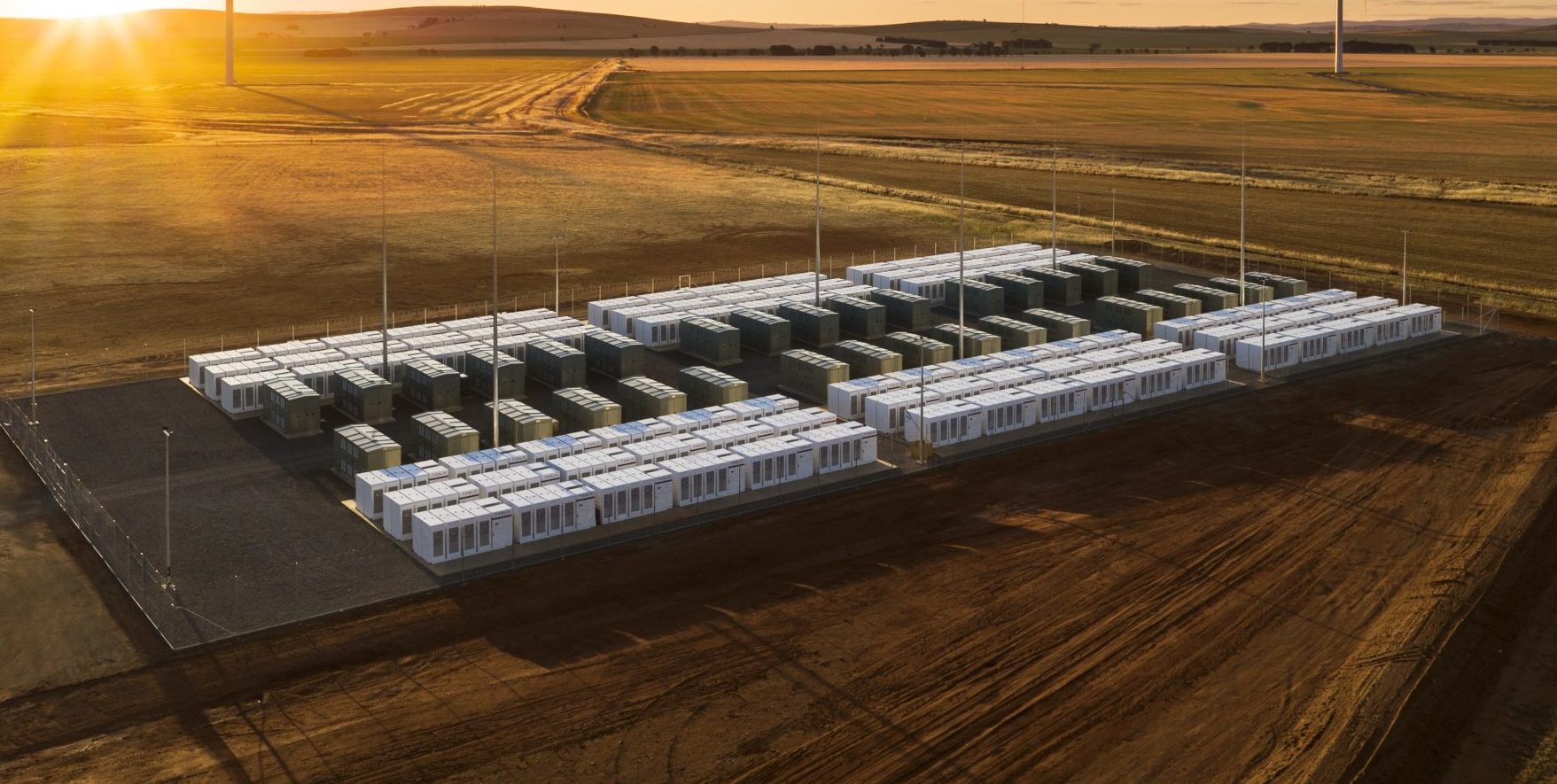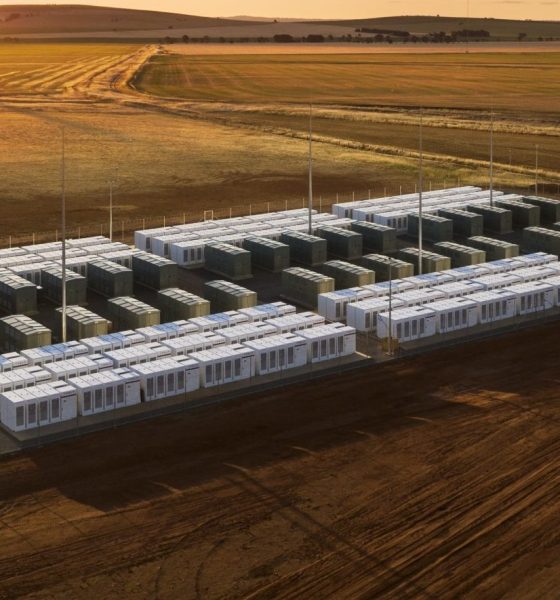

Energy
Tesla’s JB Straubel discusses batteries and scalability as new energy storage project is announced
Tesla Energy might not be attracting as much news as the company’s electric car business, but it has achieved some milestones of its own over the past few years. As of June 2018, Tesla had deployed a total of 1 GWh of energy storage worldwide, and during the company’s Q2 earnings call, Elon Musk and CTO JB Straubel reaffirmed Tesla’s commitment to growing its energy business over the coming years. Staubel even remarked that it might only be a matter of time before Tesla Energy overtakes the company’s electric car business in size.
Tesla’s batteries, such as the Powerpacks deployed on the Hornsdale Power Reserve in South Australia, are proving themselves as viable alternatives to fossil fuel-powered plants, and this is partly due to the fact that the energy industry hasn’t really evolved much over the past few decades. Tesla CTO JB Straubel highlighted this point in a recent segment with The Verge.
“You know, the electric grid hasn’t changed that much from 100-some years ago when Tesla and Edison were actually inventing it. Most people don’t realize, but it’s instantaneously matched — every time you turn on a light switch in your house, instantaneously, a power plant, somewhere, connected to that same grid, has to ramp up a little more power output to make the light operate,” Straubel said.
Most of the power used by cities today rely on large gas or coal-powered plants. In the United States, around 60% of power comes from fossil fuels, while ~20% comes from nuclear power stations. These large, baseload gas plants are consistent, but they are not very flexible. For example, when demand for power is too low, these plants lose money. When the demand gets too high, these facilities usually have to rely on faster, smaller plants called Peaker Plants to support the grid. Unfortunately, Peaker Plants are also traditionally dirtier than baseload gas plants. Straubel noted that this system causes the grid to get “dinged” on both sides.
“You get dinged when you don’t have enough load, and then when you have too much, you also get dinged inefficiently,” Straubel said.
It’s still going to take some time before clean energy solutions become capable of adequately supporting the power grid on their own. Renewable energy such as solar and wind, after all, are very promising, but they are not very consistent. Solar power can get compromised on a cloudy day, and wind power can be compromised when there is no wind. This is where battery storage comes in. Paired with renewable solutions, batteries such as Tesla’s industry-grade Powerpacks are able to store gathered energy and feed it to the grid when needed. Grid-scale chemical batteries only comprise a small part of the renewable energy market for now, but the use of batteries has been growing over the years. This, according to the Tesla CTO, would have been inconceivable ten years ago.
“That was kind of unheard of ten years ago. If you told someone that hey, a lithium-ion battery could do that sort of duty, storing solar energy every single day for ten years, they wouldn’t have believed it. I think the biggest thing is scalability. Batteries have this beautiful ability to vary economically, scale from gigawatt-hour-sized systems all the way down to 10 kilowatt-hours in your house,” Straubel said.
True to Tesla’s statement during its Q2 2018 earnings call, the list of the company’s energy projects continue to get longer. Just recently, Infigen Energy, an operator of renewable energy generation solutions in Australia, ordered a 25 MW/52 MWh energy storage system from Tesla. The batteries would be deployed at the 278.5MW Lake Bonney Wind Farm in South Australia and connected to the grid via the Mayurra substation. In a statement to Renew Economy, Australian Renewable Energy Agency (ARENA) chief Ivor Frischknecht expressed his optimism about the energy storage project.
“It is clear that grid-scale batteries have an important role in stabilizing the grid. The co-location of a battery with a wind farm provides an opportunity for Infigen to pursue regulatory changes that could improve revenue outcomes for grid-scale batteries, helping to become more competitive,” he said.
During Tesla’s 2018 Annual Shareholder Meeting, Tesla CEO Elon Musk mentioned that the company is getting closer to a battery breakthrough, with the company on pace to hit a battery cell cost of $100 per kWh by the end of 2018 depending on the stability of current commodity prices. Tesla also announced that production of residential energy products such as the Powerwall 2 and the Solar Roof tiles are set to see an increase within the next few quarters.

Energy
Tesla starts hiring efforts for Texas Megafactory
Tesla’s Brookshire site is expected to produce 10,000 Megapacks annually, equal to 40 gigawatt hours of energy storage.

Tesla has officially begun hiring for its new $200 million Megafactory in Brookshire, Texas, a manufacturing hub expected to employ 1,500 people by 2028. The facility, which will build Tesla’s grid-scale Megapack batteries, is part of the company’s growing energy storage footprint.
Tesla’s hiring efforts for the Texas Megafactory are hinted at by the job openings currently active on the company’s Careers website.
Tesla’s Texas Megafactory
Tesla’s Brookshire site is expected to produce 10,000 Megapacks annually, equal to 40 gigawatt hours of energy storage, similar to the Lathrop Megafactory in California. Tesla’s Careers website currently lists over 30 job openings for the site, from engineers, welders, and project managers. Each of the openings is listed for Brookshire, Texas.
The company has leased two buildings in Empire West Business Park, with over $194 million in combined property and equipment investment. Tesla’s agreement with Waller County includes a 60% property tax abatement, contingent on meeting employment benchmarks: 375 jobs by 2026, 750 by 2027, and 1,500 by 2028, as noted in a report from the Houston Business Journal. Tesla is required to employ at least 1,500 workers in the facility through the rest of the 10-year abatement period.
Tesla’s clean energy boom
City officials have stated that Tesla’s arrival marks a turning point for the Texas city, as it highlights a shift from logistics to advanced clean energy manufacturing. Ramiro Bautista from Brookshire’s economic development office, highlighted this in a comment to the Journal.
“(Tesla) has great-paying jobs. Not just that, but the advanced manufacturing (and) clean energy is coming to the area,” he said. “So it’s not just your normal logistics manufacturing. This is advanced manufacturing coming to this area, and this brings a different type of job and investment into the local economy.”
Energy
Tesla and Samsung SDI in talks over new US battery storage deal: report
The update was related by industry sources and initially reported by South Korean news outlets.

Recent reports have suggested that Tesla and Samsung SDI are in talks over a potential partnership to supply batteries for large-scale energy storage systems (ESS).
The update was related by industry sources and initially reported by South Korean news outlets.
ESS batteries to be built at Samsung’s Indiana plant
As noted in a report from Korea JoongAng Daily, the demand for energy storage systems has been growing rapidly in North America, thanks in no small part to the surge in AI investments across numerous companies. With this in mind, Tesla has reportedly approached Samsung SDI about a potential battery supply deal.
The deal is reportedly worth over 3 trillion Korean won (approximately $2.11 billion) and will span three years, according to The Korea Global Economic Daily. A battery supply deal with Samsung SDI could make sense for Tesla as the company already has a grid-scale battery, the Megapack, which is perfect for industrial use. Samsung SDI could simply supply cells for the EV maker.
Production of the batteries would reportedly take place at Samsung SDI’s joint venture factory with Stellantis in Indiana, which is currently under construction. Samsung SDI recently announced plans to use part of that plant’s EV lines to produce cells for ESS, with a targeted capacity of 30 GWh by the end of next year.
Tesla and Samsung’s partnership
At present, only a handful of manufacturers, including Korea’s LG Energy Solution, Samsung SDI, SK On, and Japan’s Panasonic, are capable of producing energy storage-scale batteries domestically in the United States. A Samsung SDI official issued a comment about the matter, stating, “Nothing has been finalized regarding cooperation with Tesla.”
The possible energy storage system deal adds another layer to Tesla’s growing collaboration with Samsung, which is already in line as a partner in the upcoming production of Tesla’s AI5 and AI6 chips. Early sample manufacturing of the AI6 is expected to begin in South Korea, with mass production slated for Samsung’s Texas-based Taylor foundry when it starts operations.
The AI6 chip will power Tesla’s next wave of high-volume projects, including the Optimus humanoid robot and the autonomous Cybercab service. Musk has called the partnership with Samsung a “real collaboration,” adding that he personally plans to “walk the line” at the Taylor facility to speed up progress.
Energy
Tesla VP hints at Solar Roof comeback with Giga New York push
The comments hint at possible renewed life for the Solar Roof program, which has seen years of slow growth since its 2016 unveiling.

Tesla’s long-awaited and way underrated Solar Roof may finally be getting its moment. During the company’s Q3 2025 earnings call, Vice President of Energy Engineering Michael Snyder revealed that production of a new residential solar panel has started at Tesla’s Buffalo, New York facility, with shipments to customers beginning in the first quarter of 2026.
The comments hint at possible renewed life for the Solar Roof program, which has seen years of slow growth since its 2016 unveiling.
Tesla Energy’s strong demand
Responding to an investor question about Tesla’s energy backlog, Snyder said demand for Megapack and Powerwall continues to be “really strong” into next year. He also noted positive customer feedback for the company’s new Megablock product, which is expected to start shipping from Houston in 2026.
“We’re seeing remarkable growth in the demand for AI and data center applications as hyperscalers and utilities have seen the versatility of the Megapack product. It increases reliability and relieves grid constraints,” he said.
Snyder also highlighted a “surge in residential solar demand in the US,” attributing the spike to recent policy changes that incentivize home installations. Tesla expects this trend to continue into 2026, helped by the rollout of a new solar lease product that makes adoption more affordable for homeowners.
Possible Solar Roof revival?
Perhaps the most intriguing part of Snyder’s remarks, however, was Tesla’s move to begin production of its “residential solar panel” in Buffalo, New York. He described the new panels as having “industry-leading aesthetics” and shape performance, language Tesla has used to market its Solar Roof tiles in the past.
“We also began production of our Tesla residential solar panel in our Buffalo factory, and we will be shipping that to customers starting Q1. The panel has industry-leading aesthetics and shape performance and demonstrates our continued commitment to US manufacturing,” Snyder said during the Q3 2025 earnings call.
Snyder did not explicitly name the product, though his reference to aesthetics has fueled speculation that Tesla may finally be preparing a large-scale and serious rollout of its Solar Roof line.
Originally unveiled in 2016, the Solar Roof was intended to transform rooftops into clean energy generators without compromising on design. However, despite early enthusiasm, production and installation volumes have remained limited for years. In 2023, a report from Wood Mackenzie claimed that there were only 3,000 operational Solar Roof installations across the United States at the time, far below forecasts. In response, the official Tesla Energy account on X stated that the report was “incorrect by a large margin.”








